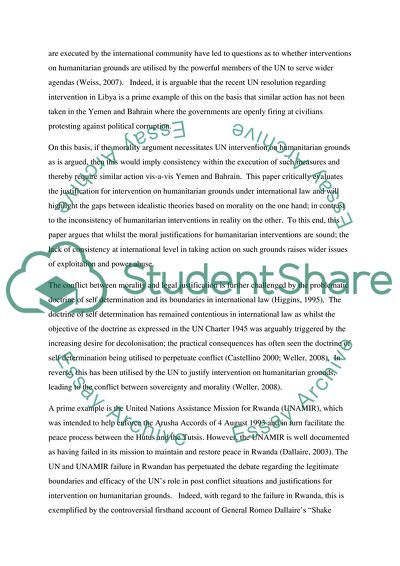Cite this document
(Humanitarian Intervention Research Paper Example | Topics and Well Written Essays - 2500 words, n.d.)
Humanitarian Intervention Research Paper Example | Topics and Well Written Essays - 2500 words. Retrieved from https://studentshare.org/politics/1750099-in-1999-then-un-secretary-general-kofi-annan-asked-if-humanitarian-intervention-is-indeed-an-unacceptable-assault-on-sovereignty-how-should-we-respond-to-a-rwanda-to-a-srebrenica-to-gross-and-systematic-violation-of-human-rights-that-offe
Humanitarian Intervention Research Paper Example | Topics and Well Written Essays - 2500 words. Retrieved from https://studentshare.org/politics/1750099-in-1999-then-un-secretary-general-kofi-annan-asked-if-humanitarian-intervention-is-indeed-an-unacceptable-assault-on-sovereignty-how-should-we-respond-to-a-rwanda-to-a-srebrenica-to-gross-and-systematic-violation-of-human-rights-that-offe
(Humanitarian Intervention Research Paper Example | Topics and Well Written Essays - 2500 Words)
Humanitarian Intervention Research Paper Example | Topics and Well Written Essays - 2500 Words. https://studentshare.org/politics/1750099-in-1999-then-un-secretary-general-kofi-annan-asked-if-humanitarian-intervention-is-indeed-an-unacceptable-assault-on-sovereignty-how-should-we-respond-to-a-rwanda-to-a-srebrenica-to-gross-and-systematic-violation-of-human-rights-that-offe.
Humanitarian Intervention Research Paper Example | Topics and Well Written Essays - 2500 Words. https://studentshare.org/politics/1750099-in-1999-then-un-secretary-general-kofi-annan-asked-if-humanitarian-intervention-is-indeed-an-unacceptable-assault-on-sovereignty-how-should-we-respond-to-a-rwanda-to-a-srebrenica-to-gross-and-systematic-violation-of-human-rights-that-offe.
“Humanitarian Intervention Research Paper Example | Topics and Well Written Essays - 2500 Words”, n.d. https://studentshare.org/politics/1750099-in-1999-then-un-secretary-general-kofi-annan-asked-if-humanitarian-intervention-is-indeed-an-unacceptable-assault-on-sovereignty-how-should-we-respond-to-a-rwanda-to-a-srebrenica-to-gross-and-systematic-violation-of-human-rights-that-offe.


